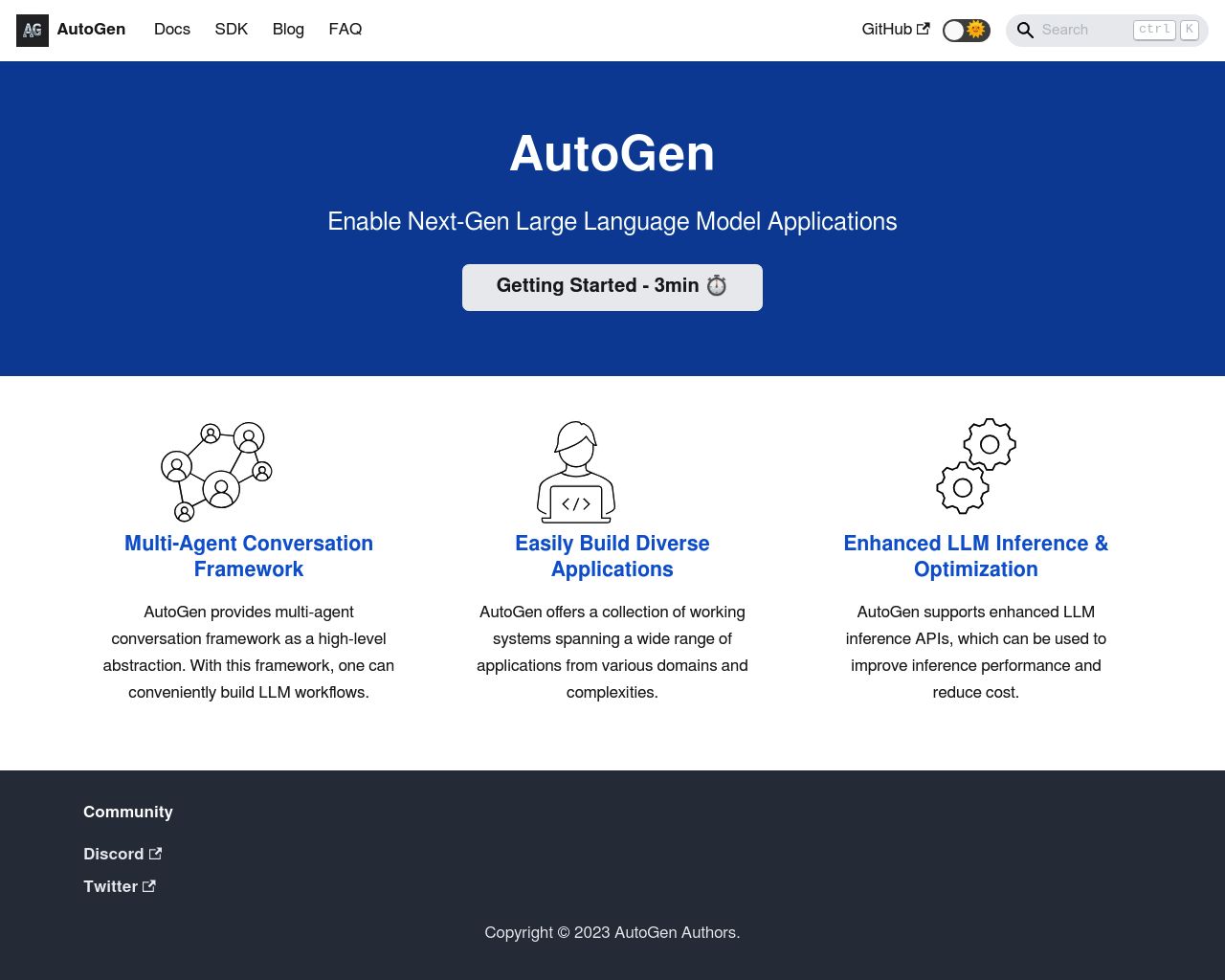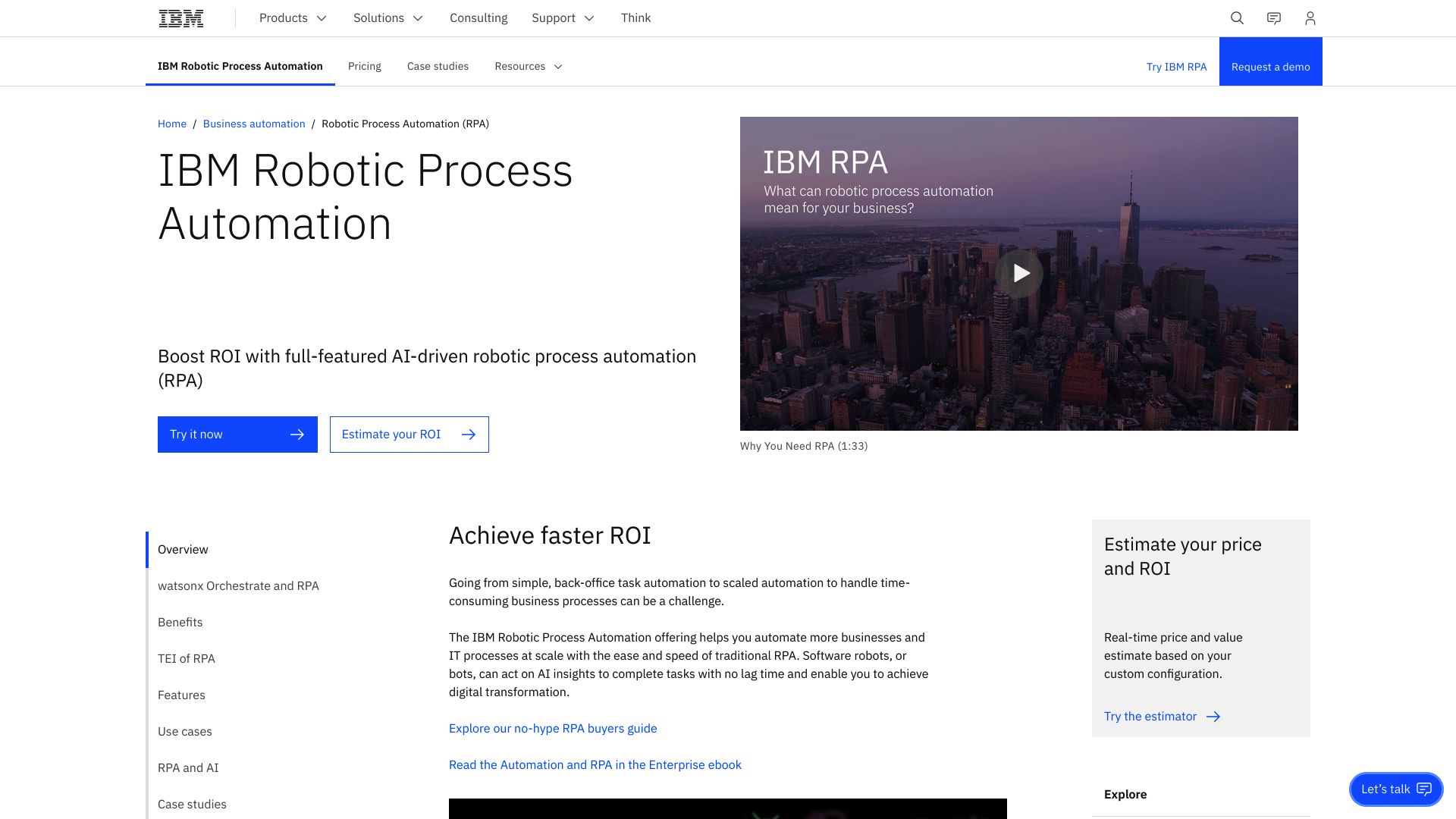AutoGen vs. IBM RPA: Feature Comparison
The AI landscape teems with innovative solutions, each vying to streamline workflows and boost productivity. This review compares three standout platforms: AutoGen, IBM RPA, and SmythOS. AutoGen empowers developers with multi-agent conversations for complex AI applications. IBM RPA offers enterprise-grade automation for repetitive business tasks. SmythOS emerges as a versatile contender, combining AI-driven agent creation with user-friendly design. We’ll explore each platform’s strengths, limitations, and ideal use cases, equipping you to choose the right automation tool for your needs. Whether you’re a seasoned developer, a business leader, or an AI enthusiast, this comparison illuminates the unique features and capabilities that set these platforms apart in the evolving world of AI automation.
AutoGen Overview
AutoGen empowers developers to create sophisticated Large Language Model (LLM) applications using multi-agent conversations. This open-source framework enables customizable agents to interact with each other, LLMs, tools, and humans to solve complex tasks.


AutoGen’s core strength lies in its multi-agent conversation system. These agents collaborate autonomously or with human input, adapting to various use cases. The framework maximizes LLM performance through enhanced inference capabilities, including tuning, caching, error handling, and templating. This optimization proves crucial when working with resource-intensive models like GPT-4.
AutoGen’s core strength lies in its multi-agent conversation system. These agents collaborate autonomously or with human input, adapting to various use cases.
Developers can tailor AutoGen agents to specific task requirements, integrating LLMs, human inputs, and external tools. The framework supports both fully autonomous operations and human-in-the-loop problem-solving, offering flexibility for applications where human oversight is essential. AutoGen demonstrates effectiveness across diverse applications, from automated task solving and code generation to continual learning and complex problem-solving in group chats.
For developers, AutoGen provides debugging tools and logging functionalities for API calls, essential for diagnosing and optimizing LLM-based systems. The framework also includes EcoOptiGen, a cost-effective technique for tuning large language models, highlighting its focus on enhancing LLM efficiency and effectiveness.
AutoGen demonstrates effectiveness across diverse applications, from automated task solving and code generation to continual learning and complex problem-solving in group chats.
While AutoGen offers powerful capabilities, it requires coding knowledge for setup and customization, potentially limiting accessibility for non-technical users. The framework’s complexity may present a steeper learning curve compared to more user-friendly alternatives. Additionally, as an open-source project, enterprise-grade support and certain advanced features may be limited compared to commercial solutions.
IBM RPA Overview
IBM Robotic Process Automation (RPA) empowers organizations to automate repetitive digital tasks across enterprise applications. This powerful platform creates software robots, or bots, that interact with user interfaces just like human operators.
IBM Robotic Process Automation (RPA) empowers organizations to automate repetitive digital tasks across enterprise applications.
IBM RPA’s cloud-based environment supports both development and production deployments. Its visual, low-code builder allows users to craft automation workflows through intuitive drag-and-drop interfaces. Bots can be triggered via schedules, orchestrations, APIs, on-demand attended automation, and even chatbots, offering flexibility in execution.
IBM RPA scales effectively through distributed runtime environments and orchestration processes. The platform integrates seamlessly with common enterprise applications like Microsoft Office, SAP, Java-based systems, and web apps. This wide compatibility enables bots to automate tasks across diverse software ecosystems.


IBM RPA includes robust monitoring, analytics, and auditing capabilities. These features provide valuable insights into bot performance and process efficiency, enabling continuous improvement of automation workflows. The platform addresses enterprise-grade security and compliance requirements, making it suitable for organizations with stringent data protection needs.
IBM RPA includes robust monitoring, analytics, and auditing capabilities… providing valuable insights into bot performance and process efficiency.
While IBM RPA offers significant benefits, users should consider potential drawbacks. The platform’s enterprise focus may result in a steeper learning curve for smaller organizations or individual users. Additionally, the cost structure might be prohibitive for some businesses, particularly those just starting their automation journey.
Feature Comparison
AutoGen and IBM RPA offer distinct approaches to automation, with AutoGen focusing on AI-powered multi-agent systems and IBM RPA specializing in task-specific software robots. AutoGen excels in creating customizable AI agents that can collaborate autonomously or with human input to solve complex problems. Its framework supports enhanced Large Language Model inference, making it ideal for developers working on sophisticated AI applications. IBM RPA, on the other hand, provides a robust platform for automating repetitive business processes across enterprise applications, utilizing software bots that mimic human interactions with user interfaces.
A key difference lies in their core components. AutoGen’s strength is its flexible multi-agent conversation system, which allows for dynamic problem-solving and adaptation to various use cases. This makes it particularly suited for tasks requiring complex reasoning and decision-making. IBM RPA, while less flexible in terms of AI-driven decision making, offers a more straightforward approach to automating predefined tasks and workflows, making it accessible to business users without extensive coding knowledge.
In terms of security, IBM RPA has a clear advantage with its enterprise-grade features designed to meet stringent corporate requirements. It provides robust data encryption, access controls, and audit trails, essential for organizations handling sensitive information. AutoGen, while offering some security measures, does not match IBM RPA’s comprehensive enterprise security framework, potentially limiting its applicability in highly regulated industries.
Feature Comparison Table
| AutoGen | IBM RPA | SmythOS | |
|---|---|---|---|
| CORE FEATURES | |||
| AI Agents | ✅ | ❌ | ✅ |
| Visual Builder | ❌ | ✅ | ✅ |
| No-Code Options | ❌ | ✅ | ✅ |
| Memory & Context | ✅ | ❌ | ✅ |
| Autonomous Agents | ✅ | ❌ | ✅ |
| Explainability & Transparency | ✅ | ❌ | ✅ |
| Multimodal | ✅ | ❌ | ✅ |
| Problem-Solving Capabilities | ✅ | ❌ | ✅ |
| Multi-Agent Collaboration | ✅ | ❌ | ✅ |
| Work as Team | ✅ | ❌ | ✅ |
| Agent Work Scheduler | ❌ | ✅ | ✅ |
| SECURITY | |||
| Constrained Alignment | ❌ | ❌ | ✅ |
| OAuth | ✅ | ❌ | ✅ |
| IP Control | ❌ | ❌ | ✅ |
| COMPONENTS | |||
| Foundation AIs | ✅ | ❌ | ✅ |
| Huggingface AIs | ✅ | ❌ | ✅ |
| Zapier APIs | ✅ | ❌ | ✅ |
| Classifiers | ✅ | ❌ | ✅ |
| Data Lakes | ❌ | ❌ | ✅ |
| DEPLOYMENT OPTIONS (EMBODIMENTS) | |||
| Deploy as Webhook | ✅ | ❌ | ✅ |
| Staging Domains | ❌ | ❌ | ✅ |
| Production Domains | ❌ | ❌ | ✅ |
| API Authentication (OAuth + Key) | ✅ | ❌ | ✅ |
| Deploy as Site Chat | ✅ | ❌ | ✅ |
| Deploy as Scheduled Agent | ❌ | ✅ | ✅ |
| Deploy as GPT | ✅ | ❌ | ✅ |
| DATA LAKE SUPPORT | |||
| Hosted Vector Database | ❌ | ❌ | ✅ |
| Sitemap Crawler | ❌ | ❌ | ✅ |
| YouTube Transcript Crawler | ❌ | ❌ | ✅ |
| URL Crawler | ✅ | ❌ | ✅ |
Conclusion
AutoGen, IBM RPA, and SmythOS each offer unique approaches to automation and AI integration. AutoGen excels in creating flexible multi-agent systems for complex problem-solving, while IBM RPA focuses on automating repetitive business processes with software bots. SmythOS, however, stands out by combining the strengths of both platforms and addressing their limitations.
SmythOS provides a user-friendly, drag-and-drop interface that simplifies AI agent creation without sacrificing advanced capabilities. Unlike AutoGen’s steeper learning curve, SmythOS makes sophisticated AI accessible to both technical and non-technical users. It surpasses IBM RPA’s task-specific focus by offering a versatile platform for creating intelligent agents that can handle complex, adaptive workflows.
Our platform’s extensive integration ecosystem, supporting over 300,000 integrations, outshines both AutoGen and IBM RPA in terms of connectivity. This vast network allows SmythOS to seamlessly fit into diverse business environments, enhancing its utility across industries. Additionally, SmythOS’s ’Create Once, Deploy Anywhere’ approach provides unparalleled flexibility, allowing agents to be deployed across various platforms and services with ease.
For those ready to experience the future of AI automation, we invite you to explore our diverse range of AI-powered agent templates. These templates offer a quick start to revolutionizing your workflow across multiple business categories. To see how SmythOS can transform your specific needs, create a free SmythOS account and start building AI agents at no cost, with no time limit. Join us in shaping the future of work with SmythOS – where innovation meets simplicity in AI automation.
Last updated:
Disclaimer: The information presented in this article is for general informational purposes only and is provided as is. While we strive to keep the content up-to-date and accurate, we make no representations or warranties of any kind, express or implied, about the completeness, accuracy, reliability, suitability, or availability of the information contained in this article.
Any reliance you place on such information is strictly at your own risk. We reserve the right to make additions, deletions, or modifications to the contents of this article at any time without prior notice.
In no event will we be liable for any loss or damage including without limitation, indirect or consequential loss or damage, or any loss or damage whatsoever arising from loss of data, profits, or any other loss not specified herein arising out of, or in connection with, the use of this article.
Despite our best efforts, this article may contain oversights, errors, or omissions. If you notice any inaccuracies or have concerns about the content, please report them through our content feedback form. Your input helps us maintain the quality and reliability of our information.
